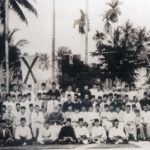|
One of the significant minorities who made their presence in Penang from the late 19th to early 20th centuries came from Japan. In 1910, the official census counted 207 Japanese residents in Penang alone. Unlike the present day Japanese expatriates living in Penang, those early-day Japanese settlers were much poorer in comparison and in fact more than half of the Japanese residents then were involved in the ‘flesh’ trade. No of registered Japanese residents in Penang as at end of December, 1910
Source: Overseas Japanese population census by the Acting Consul of Japan in Singapore, Mr. Iwatani (1910) The early Japanese in Penang Karayuki -san Since these areas are close to the seaport of Nagasaki which has good connection to travel to the Asian continent and S.E. Asia, the peasants and fishermen who were poverty stricken and facing the threat of long-term famine had little choice but under the persuasion of the prostitute racketeers called Zegen, to sell their daughters to work as Karayuki-san or prostitutes overseas. (Note: Karayuki means one who went to China). Despite the difficult lives many of the Karayuki-san led abroad, they were often stalwart patriots who sent money back home to support both their impoverished families. The money which these Karayuki-san remitted back to their homeland contributed a large foreign reserve to the Japan’s economy at that time. During the Japan’s expansionist wars in Qing Dynasty China in the mid 1890’s and Czarist Russia in 1905, the brothel owners used the idea of national good to enslave the young girls and women who were told that their bodies belonged to the state and that they constituted a form of female army. The victory over the Russians in 1905 saw an up surge of nationalism and racial pride in Japan and by 1910, the voice of abolishing this disgraceful overseas ‘flesh’ trade began to be heard from the overseas Japanese community leaders and Japanese officers traveling abroad. However, it was not until 1920 that Japanese Government, in collaboration with the British administrators who was concerned about the epidemic spread of the venereal diseases, began to abolish this ‘flesh’ trade and forced the Karayuki-san to leave the Straits Settlements and the Malay states. Most of them were sent back to Japan for good and for those who refused to do so, they either went ‘under-ground’, married the locals or tried their luck in the major cities of China.
Doctors, Dentists and Pharmacies Photo Studios and Silent Movie Theatres Hoteliers & Inns Keepers The Little Japan at Cintra Street & Kampung Malabar The Penang Japanese Cemetery There were 56 tombstones found in this cemetery with the earliest one dated back to 1893 (Meiji 26th Year). Contrary to popular belief, this cemetery is not a burial ground for the Japanese soldiers killed during the Second World War. In fact, only one tombstone dated 30.7.1942 belonging to one Kataoka from Troop 5174. All the other 55 tombs are dated between 1893 – 1926. The majority of the Japanese who were buried or commemorated here consist mostly the Karayuki-san who died during the Meiji Period (1868 – 1911) and a number of Japanese Navy officers who died in the sea waters near Penang during the Taisho Period (1912 – 1925 ). Evacuation of the Japanese Residents In the 1930s, the Japanese invasion of Manchuria and China sparked a series of anti-Japanese campaigns by the Chinese community in Malaya. In 1935, the Japanese Club in Singapore was ransacked by about 200 Chinese rioters. In Penang, in-line with the anti-Japanese campaigns in China, Chinese leaders actively instigated the people to boycott Japanese goods and services. In 1937, sensing the tense and dangerous situation, the Japanese wives and children living in Malaya & Singapore were tacitly advised to evacuate and return to Japan by their authorities and the community leaders and this evacuation intensified just before the War in 1941. The Chinese had long suspected all the local Japanese were spies for the Imperial Japanese government but only a handful of Japanese residents that remained behind were true collaborators to the Japanese invaders. During the War, the main informants were the Chinese merchants who traded Japanese goods before, the Taiwanese who could speak both Hokkien & Japanese and the Chinese police inspectors who pleaded their allegiance to the new master. Some shops operated by the Japanese just before the war included a dental clinic owned by Mitsutake family at the junction of Muntri St and Leith St, a crockery shop named Nagoya sitting beside the Odeon Theatre and a toy shop in the Tong Aik Building at the corner of Hutton Lane and Penang Road. The Asahi Hotel at Transfer Road was an officially appointed hotel by the Japanese Government and it was suspected being used as a base for the Japanese espionage activities in this region. Conclusion Compared to the present day Japanese expatriate community in Penang, the early days Japanese settlers had more interactions with the locals at the grass root level. It is important that these Japanese being recognised as one of the ethnic groups that had made significant contributions to Penang’s early development and their role should not be mixed up with the Japanese military invaders who came later with a totally different intention. It is an undeniable fact that the Japanese have left an indelible mark on Penang’s history and their culture had woven into the social fabric of Penang in those days. References: 2) Prewar Japanese Community in Singapore – Picture & Record, The Japanese Association in Singapore, 1998 3) The Penang Japanese Cemetery Record 4) Kumamoto Nichi-nichi Shimbun, 4th Oct, 1999 5) Present Situation of the Japanese Activities in Malaya, The South Seas & The Japanese Club, 1917 6) Sandakan’s Number 8 Brothel, Tomoko Yamazaki, 1972 |
||||||||||||||||||||||||||||||||||||||||||||||||||||||||||||||||||||||||||||||||||||||||||||||||||
| Clement Liang |
/images/mino-content-clement2.jpg)

